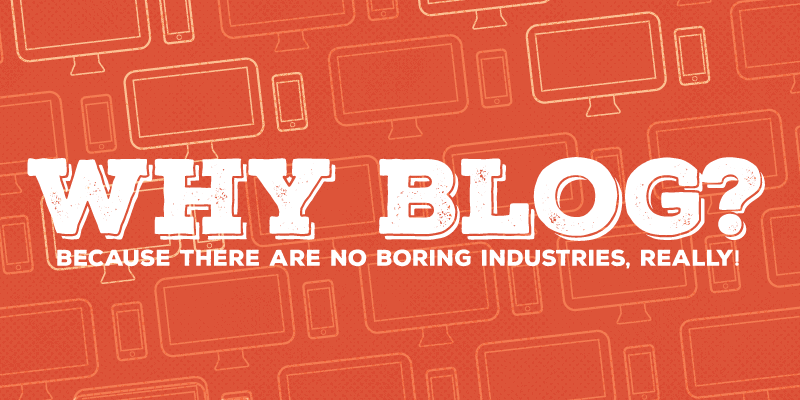With so many different blog post types to relay your brand’s story, how do you figure out where to begin?
You know your story, but how are you going to tell it? It’s easy to think of a blog post and automatically assume it will include only words. While words are important for SEO reasons, they aren’t the only method of telling your story. There are various ways you can incorporate different types of media to enhance your post, such as by adding videos, infographics, and other content.
Here’s a brief overview of some of the media you can use for these blog post types from time to time.
Images
We always recommend including at least one picture in every single blog post you share. Why? Well, for one reason, consumers are visually driven, and sharing a picture will help them automatically identify to the message you’re sharing. Pictures can also help share your message via social media. Engagement on Facebook and Twitter tend to be higher when posts include pictures, and apps such as Pinterest and Instagram revolve around the sharing of photographs. Images are one way to keep your evergreen content current and fresh. In the image-centric world of social media, pictures are becoming a universal language, so choose your image wisely. At BuzzFarmers we encourage our clients to invest in custom illustrations from our portfolio of local artists to add even more depth to blog posts.
Best Practice: If you aren’t using your own images, be sure to give credit to any images you share on your site.
Videos
Like many blog post types, videos are used to grab the attention of readers. Videos have the power to build emotion, which elicits a response from readers. Sharing videos of yourself or employees can build trust by means of nonverbal communication. Videos don’t necessarily need to be of a human speaking. Share videos of employees working, products being built, or anything else that is relevant and backs up the information you’ve written on the blog post.
Best Practice: Embed your video into your post instead of just linking to it. We use Wistia for our video embedding, and love the product. They also make great video blogs.
Infographics
Using infographics in a blog post is a way to disseminate information such as statistics in a creative way bound to capture your readers attention. They can also be used to reinforce the written points you’re making. Infographics are especially shareable via Pinterest, which after being shared on the site can drive traffic regularly to your site from new readers who hopefully turn into new customers.
Best Practice: Be the first person to “pin” your infographic to Pinterest to garner more traffic to your blog.
GIFs
GIFs are fun. While we use these sparingly, we appreciate the power they seem to hold over social media. There are many successful examples of companies who use GIFs on posts that go viral. We love Barkbox’s regular GIF dog posts. While they don’t necessarily do anything to sell their product, the posts help build their audience base, as they are easily sharable across social media platforms. They more people viewing the posts, the better brand recognition for Barkbox.
Best Practices: Always source where the GIF was found. Don’t overdo these blog posts.
Interviews
Interviews are great to include on your blog. This will give your audience a chance to hear from people you admire. It will also give you the opportunity to add a new voice to your blog. Interviews are a great opportunity to highlight other people your readers may find interesting. Construction companies could interview realtors, interior designers, insurance companies, and building-supply companies that they often work with. The information shared will still be relevant to the blog readers, but will give them a different perspective than you may have been able to offer.
Best Practices: Be sure your interviews are relevant to your blog topic. Also, as the interviewer, it’s your responsibility to ask thoughtful, insightful questions to get the best answers from your interviewee.
Questions & Answers
Occasionally you may want to do a post to answer the questions of your customers. To prepare for this post, ask readers to Tweet, Facebook, or email you any questions they may have about your product or company. After reading all the questions you receive, curate the most appropriate questions into a blog post and answer in a detailed, though precise manner.
Best Practice: Set up a timeline for readers to ask questions, and be sure your post with answers goes live shortly after to keep the momentum and interest high.
Screenshots
Are you quoting an article you read or discussing a company you admire? Why not include a screenshot to back up your post? Not only will it reinforce the statement you’re trying to make, but like pictures, it will break up the text on your blog post. If you’re doing a Q&A blog post type, you may consider using screenshots of the questions you were asked. These would be great to include in your post.
Best Practice: Be sure you have permission to screenshot any images you’re including, or give credit to the site you screenshotted.
Reviews
Do you use a product or app that’s integral to your business? Shout it out with a blog post. This give you a chance to talk about the behind-the-scenes of your business, while also giving credit to other companies, as well. By reviewing other companies professionally on your blog, your content will be shared with your readers, but it’s also likely that the product’s general audience will find and read your post, possibly getting you new readers, as well.
Best Practice: Reviewing companies on your blog is a great practice, but remember: Anything you share on your company blog is a direct reflection on your company. Only write reviews that reflect your values.
Lists
Regardless of your tone or style, using lists in your blog posts will appeal to all reader types. In fact, you could even speak to multiple personas by writing one list. Lists can be used for a variety of reasons, such as promoting a product. Lists could be used to explore a topic by making a variety of points. Lists are a great way to share information with your readers in easy-to-digest snippets of information.
Best Practice: Don’t fluff your list with content that doesn’t emphasize your points. Make your point and move on.
One Last Tip
Think about personas when creating content for different blog post types. Depending on your blog topic, some of these media forms will work better toward one persona than they may another. Know the persona you’re speaking to and be sure the media you incorporate in your post speaks to that persona.
What blog post types do you use most often? If you’re having trouble deciding between media options, contact us for some help!





